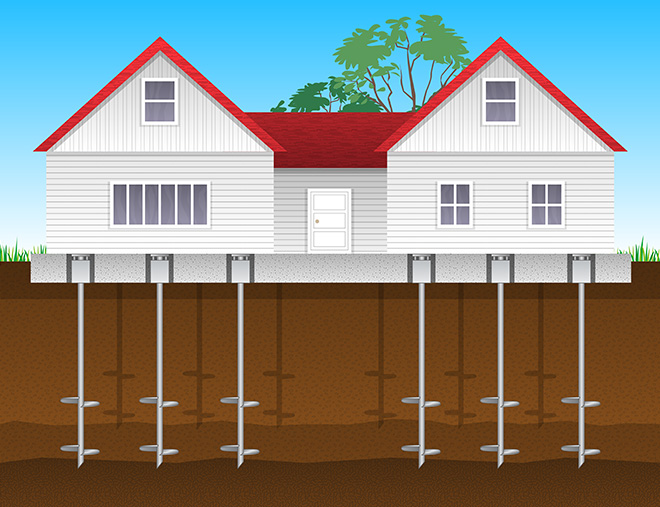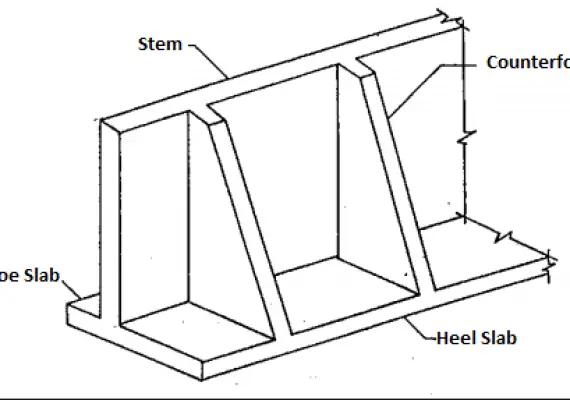What is Piering Foundation? |Piering Foundation Cost | Types of Piers for Foundation Repair
What is Piering Foundation? | Piering Foundation Cost | Types of Piers for Foundation Repair
What Is Piering Foundation?
Piering foundation is a process of stabilizing the soil beneath a building’s foundations to prevent settlement. This can be done by inserting steel rods below the footing and filling the space with concrete or grout.
This article will provide information about piering foundation, including how it works, what types there are, and when you should use them. It will also cover safety precautions and tips for homeowners who want to do this themselves.
Piering is a process in which the foundation of a building, often an older or historic structure, is repaired by replacing the structural elements with new ones. It is process in which steel rods are inserted into the foundation of a building to strengthen it.
It can be done to repair cracks, such as those caused by frost heaving or earthquake damage. It can also be used when there is not enough soil around the base of the foundation for deep foundations, and if an existing concrete slab has cracked or buckled due to poor workmanship during installation.
In some cases, this may be done to seal off cracks around the base of the foundation that could allow water to seep into it and cause damage.
However, piering can also be used for other reasons such as providing additional support if there are not enough structural elements available or simply making a house more level.
How Is Piering Foundation?
For some homeowners a pier and beam foundation is the best way to rebuild their home after a natural disaster. This type of foundation typically involves constructing piers on each side of the home, which are then filled with concrete.
The foundation piering fixes a foundation that has areas of settlement. Piers are often needed when the holes created by settlement are too large to be filled with concrete.
Piers are like pilings, and are usually made of steel or other high-strength materials. The piers are placed deep into the ground and attached to the concrete.
After this phase is complete, a beam is then installed and the beams are secured to the piers with bolts. In addition, the beam is also attached to the house with steel plates which are screwed in place.
The piers stabilizes the foundation and carries the weight of the home. Piers are a good option because they are more cost-effective than major rebuilding. The piering foundation is a quick, efficient, and cost-effective way to repair a foundation problem.
This new type of foundation can last for more than 100 years!
Foundation piering does not require any excavation work and may save time and money on construction projects that would otherwise have to wait until weather conditions improved for excavating.
Types of Piers for Foundation Repair
There are several types of piers used in foundation repairs. Namely
1. Helical Piers
A helical pier, often known as a “anchor” or “pile,” is a foundation solution that is frequently used to stabilize a front porch. In this situation, the pier does not need to support a large amount of weight.
Helical piers are similar to huge screws. They are made of steel and are propelled deep into the earth by a hydraulic torque motor. At this point, hydraulic jacks are used to raise the sinking foundation to the proper level, after which it is secured by bolted or welded wall brackets.
2. Eccentrically Loaded Push Piers
Push piers are typically used in applications where heavy loads must be supported by the foundation. The load is supported in the center of the pier, but is not evenly distributed over the cross-section. This type of pier will typically require piles that are longer and thinner than those used for helical piers.
3. Multiple Piers
In some situations, a foundation will need to support more than one load at a time (e.g., building two houses side-by-side). This type of foundation requires a pier, which is comprised of several piers that are either stacked or connected together.
4. Multi-Layer Piers
A foundation with multiple layers must have multiple piers over its entire span. These can be wedge-shaped (a “pile cap”) or both wedge-shaped and multi-layered (known as a “double-drum”).
5. Impact Crushers
These piers are very similar to multiple inward-facing helical piers on multi-layer foundations. However, they are not typically used for long spans.
6. Stone Piers
Longer piers are also sometimes known as “stone pier.” This is because the pier is built from stones, rather than concrete. The thickness of these piers tends to vary depending on their location in the ground (generally thicker in areas with higher ground pressure). Stone pier foundations do require more labor as their construction involves digging each stone individually and carefully placing each one where it is needed.
How much does Foundation Piering Cost?
Piering is placing supports underneath the house at several different points and is considered a permanent solution. Each pier costs roughly $1,340, and repairs for a typical-sized home necessitate 8 to 10 piers. This strategy will cost you between $10,720 and $13,400. Hiring a structural engineer may cost between $300 and $1,500.
Advantages of Piers on Concrete Foundations
Advantages of piering include;
- A low cost (compared to full excavation). Up to ten times less than replacing the building foundation
- There is no need for heavy equipment
- There is minimal disruption to landscaping.
- In one step, fix both the cause of the settlement (unstable soil) and the effects (living out of level).
Foundation Repair – Foundation Piering Saves This New Construction Home From Collapsing
11 Top Signs of Foundation Problems
As a homeowner, you should keep an eye on foundation damages and issues. It’s easy to dismiss minor faults since you’ve been told that “houses settle” or you’re terrified of finding something wrong.
However, foundation difficulties do occur, especially if you reside in a region with expansive soil or that receives a lot of rain.
A foundation problem does not necessarily indicate that your house is doomed; competent foundation repair professionals have a solution for almost every imaginable circumstance. But keep in mind that foundation issues do not resolve themselves, and time is not on your favor.
Keep an eye out for the following frequent indicators of foundation problems, and be sure to contact a foundation repair professional if you have any concerns.
Bowing Or Sagging Walls
Sagging walls are one of the most common indications of foundation problems. They’re also a problem to fix when you own the house, as a good seal is essential for the integrity of your home.
In some cases, a sagging wall is the result of insufficient backfill or other soil issues; in other cases, it’s due to settling. If you notice that your house is leaning at all, consult a foundation professional for a solution as soon as possible.
Water In Basement
If you have a basement, be on the lookout for water problems. Most houses have a waterproofing layer, but this layer can fail if your foundation is damaged or needs repair.
A wet basement is an indicator that something beneath the surface has gone wrong. It can be a faint sign of something minor, such as cracks or foundation settlement.
However, it can also be the result of a major problem such as inadequate drainage or poor concrete work that shelters moisture from reaching the outside air.
Fixing a wet basement can be difficult, but in some cases it’s possible. Waterproofing will quickly become ineffective once the waterproof layer is compromised, and there may not be enough space to repair it.
At this point, you have to consider your options and make the appropriate decisions.
Cracks Or Fissures In Concrete Foundation
You might notice cracks in the concrete when you periodically kick a hole through it, but these cracks do not have to be caused by foot traffic. When water infiltrates the ground, it becomes weaker and can cause cracks.
These cracks should not be ignored, as they could lead to larger damage. You will need experienced help to repair the foundation properly.
Cracks In Cement Or Brick Veneer
Cracks in brick and mortar are another cause of concern because they are similar to plaster walls that are vulnerable to moisture intrusion when your foundation is damaged.
It’s important to address any cracks that appear or, if necessary, reinforce them.
Cracks In Flooring
A crack in the floor indicates stress on your foundation, which means that it needs to be repaired as soon as possible.
Shifting Or Cracking Floors
Flooring that is not properly attached to your home’s foundation can shift and crack. This may just mean that your house has shifted a bit, but it could also be an indication of severe foundation issues.
The typical reason for flooring to move is poor drainage, and being able to pinpoint this issue will help in fixing it.
Water may not reach its intended destination because of a damaged foundation, so you must make sure that your floor is fastened properly.
This can be a difficult task since many homeowners are unaware of the fact that their floors are not securely attached to the wall or columns.
Nail Pops
If your home’s nail pops regularly, it could be an indication of problems in your foundation. They usually occur when the foundation has shifted and the wood has to be nailed back into place.
Bowing Walls Or Doors
A bowing door or wall may just have been accidentally bumped into, but it can also be a sign that you have foundation problems. The bowing may just be cosmetic, but it could also indicate serious damage.
A bowed wall is not strong enough to support anything that might possibly lean against it, such as heavy furniture or a piano. The best thing to do is gain help from a foundation repair company.
Cracks In The Basement
If you notice a crack in the basement, this could mean that there is settlement on your property.
You should immediately contact a foundation repair contractor to have it fixed as soon as possible.
If you fail to do so, the crack will probably widen and develop into a more serious problem that may require structural reinforcement. Your home’s walls may even begin to buckle if you ignore this problem.
Cracked Concrete Basement Floor
Foundation cracks are most common in the walls, but the floors of a home can also be damaged.
If you have a cracked concrete basement floor , it is likely that your house suffered some kind of damage in a storm or that it has settled over time. In any case, it represents a potential health hazard due to the fact that moisture may seep into the living space through the crack.
The longer the crack remains unrepaired, the more serious it can become. Once this happens, mold may rapidly grow inside the house and cause all kinds of health problems.
Understand that a contractor is needed for a professional repair work on a roof leaks and that it requires certain skills.
If you have located your leak and start working on it on your own, you will most likely end up making the problem significantly worse than when you initially began.

